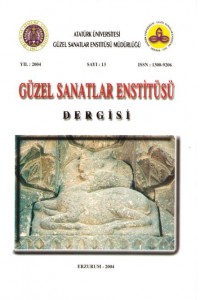Abstract
KARAHANÖzet
Makalemizin konusı.tnu oluşturan Gülsarya kilimlerinin adını ilk defa Sarya
isminde bir bayanın dokuduğu kilimden aldığı sanılmaktadır. Bu dokumaların ana
unsurunu üzerlerinde taşıdıkları elibelinde ya da Sarya Gülü motifleri
oluştunnaktadır. Motifler renklerin de yardımıyla yamuk dörtgen şekilleri
oluşturacak şekilde kompoze edilmiştir.
Kilimlerde yün ve ağırlıklı olarak doğal boyalar kullanılmaktadır. Lacivert,
kahverengi, siyah, kınnızı , beyaz ana renklerin yanında yeşil, sarı, mavi, bordo
gibi diğer renkler de bulunmaktadır. Kilimler taban, divan, yolluk, sofra, yastık gibi
çeşitlere ayrılmaktadır.
Elibelinde ya da Sarya Gü1ü denilen motifler kilimlerin tamamında
görülmektedir. Fakat b motiflerin sıralınışı kilimlere kimlik kazandırmaktadır.
Gülsarya kilimlerinde elibelindenin yanında, örümcek, koçbaşı, yıldız, kurağzı,
deve ayağı, keçi ayağı, beştaş, tarak motifleri de bulunmaktadır.
Kilim zeminini çevreleyen bordurlerin sayısı genelolarak bir tanedir. Eski
kilimlerde uzun ve kısa kenarlarda yer alan motifler değişirken, yeni kilimlerde her
iki kenarda aynı motifler tekrar edilmektedir.
Teknolojiye yenik düşen pek çok el sanatı ürüiılerine baktığımızda, Van'daki
kilim örneklerinden Gülsaryaların gelenekselolarak yaşatılmaya çalışıldığını
görmekteyiz. Bu durumun devam edebilmesi için dokuyuculara desenleri ve
kompozisyonları bozulmamış örneklerin verilmesi yöresel değerlerin
korunmasında buyük etken olacaktır.
Anahtar Kelimeler: Van, Renk, Kilim, BordUr:Çift Kanat, Sarya Motifi
Abstract
lt is assumed that the subject of our article, Gülsarya Kilims, has fırst taken
its n.ame after th kilims woven by a woman called Sarya.
Sarya Rose and hand-on waist motifs comprise the main features of these
kilims. The motifs were composed in a way to form irregular rectangular patterns
with the help ~f colours.
Wool and heavily natural dyes are used in the kilims. Besides main colours
dark blue, brown, black, red and white, other colours such as green, yellow, blue
and claret red were also used. The kilims are in various types; floor, sofa, runner
tableeloth and pillow kilims.
Hands-on-waist and Sarya Rose motifs are seen in all of the kilims. Vet, the
order of the motifs give the kilims an identity. Iri Gülsarya kilims besides hand-onwaist
motif, motifs called spider, rams's head, star, wolfs mouth, camel-Ieg, goat
leg, fıve-stones, and comb are also seen.'
The number ofborders surrounding the kilim background is generailyone. In
the old kilims, while the motifs on the long and short sides change, the same motifs
are repeated on both sides in the n~w ones.
Looking at the products of many hand-crafts, weakened by technological
advances, we see that Gülsarya, of the kilim examples from Van is being helped to
survive In order to continue the productiop of these kilims it is vital to give
weavers origina! examples of patterns and composition of kilims to protect the
loca! values of the region.
Key Words: Van, Colour, Kilim (pileless carpet), Border, Both Side, Sarya
Motifs
Keywords
Details
| Primary Language | tr; en |
|---|---|
| Journal Section | Articles |
| Authors | |
| Publication Date | March 4, 2010 |
| Submission Date | March 4, 2010 |
| Published in Issue | Year 2004 Issue: 13 |
Obtaining permissions for studies requiring ethics committee approval regarding the implementation of ethical rules and including information about permission in the article was added to the criteria. In this direction, Ethics Committee Permission is required for articles submitted to our journal and meeting the conditions stated below.
• Any research conducted with qualitative or quantitative approaches that require data collection from participants using questionnaires, interviews, focus group work, observation, experimentation, and interview techniques.
Also;
• Obtaining and indicating permission from the owners for the use of scales, surveys and photographs belonging to others,
• It should be stated that the copyright regulations are complied with for the intellectual and artistic works used.


